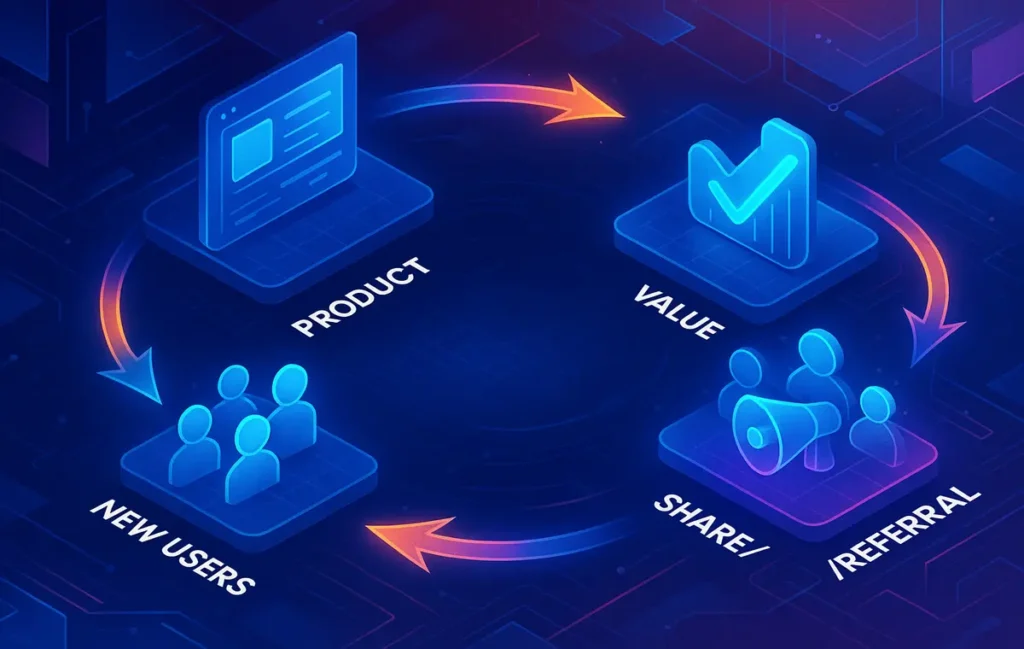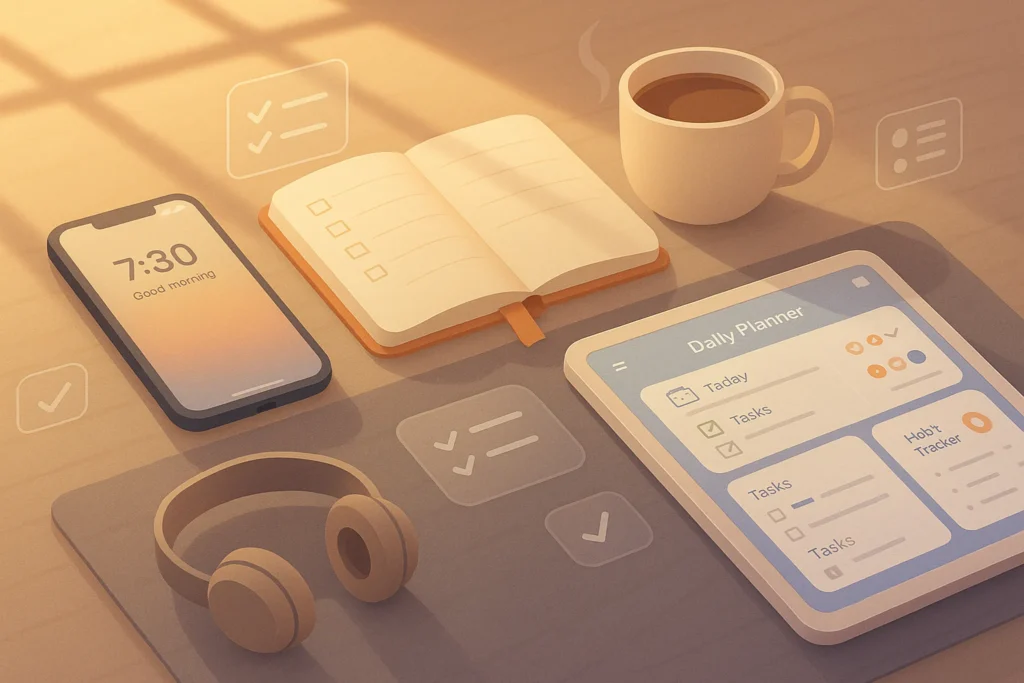🚀 Intro
Marketing costs are rising. Ad platforms are saturated, customer acquisition costs (CAC) climb every quarter, and for small SaaS, AI apps, or indie creators, competing in crowded channels feels impossible. Yet some of the fastest-growing companies manage to expand without massive ad budgets.
The secret? They let the product itself become the growth engine. Instead of paying for reach, they design experiences where users naturally share, invite, and amplify the product. This is the promise of Product-Led Growth (PLG): turning your own customers into your most powerful marketers.
💡 Nerd Tip: When growth comes from the product experience itself, every new user isn’t just a customer—they’re a potential distribution channel.
🔍 What is Product-Led Growth (PLG)?
At its core, Product-Led Growth means your product—not ads, not outbound sales—is the main driver of user acquisition, activation, and retention. A PLG strategy creates experiences where each user action can unlock growth loops, such as inviting colleagues, sharing content, or creating templates that spread virally.
This differs sharply from sales-led growth (where growth depends on direct sales teams) or content-led growth (where articles, guides, and SEO do the heavy lifting). PLG can complement these models but stands apart because the product experience itself drives awareness and distribution.
Why is 2025 the golden year for PLG? Because AI apps, SaaS tools, and even simple Notion templates can be distributed globally with almost no marketing team. Zero friction onboarding, freemium models, and embedded viral features mean you can achieve scale without burning cash.
Companies like Slack, Figma, and Canva have shown how powerful PLG can be at enterprise level. But solopreneurs can apply the same logic with AI-powered apps or even side projects. A simple AI note-taking tool with a free sharing feature can grow faster than a heavily advertised competitor.
🌟 Why Users Make the Best Marketers
There’s a reason PLG is so powerful: people trust other people more than they trust ads. Word of mouth is still the strongest driver of purchase intent.
When a user shares your product with friends, creates content about it, or leaves a testimonial in a community forum, it carries more weight than your most polished ad campaign. Social proof works because it feels authentic. Communities amplify this trust—think of how a conversation in a Discord group about a new AI tool can trigger dozens of sign-ups instantly.
There’s also a direct financial benefit. Every time a product spreads through referrals or organic sharing, CAC drops. Instead of buying clicks, you convert natural touchpoints into marketing opportunities. For bootstrapped founders, this isn’t just efficient—it’s survival.
💡 Nerd Tip: Users become marketers when their own success depends on sharing your product. Build loops where their growth and your growth align.
User advocacy works best when stories are told authentically. While referral links are powerful, nothing beats a compelling user story that resonates with peers. That’s why companies that succeed with PLG often invest in teaching their users storytelling techniques, encouraging them to share experiences that feel natural. This overlaps with the principles of Storytelling in Content Marketing, where narratives build trust and community-driven credibility.
🧩 Core Tactics to Turn Users into Marketers
Referral Loops
The oldest but still one of the most effective PLG tactics. Give users a reason to invite others by rewarding them with something valuable inside the product. Dropbox grew exponentially by offering extra storage for referrals. Instead of offering external discounts, they reinforced core value—more space.
User-Generated Content (UGC)
Encourage users to create assets that showcase your product. Canva built its empire by letting users design and share branded templates, effectively turning each design into a marketing touchpoint. Similarly, SaaS tools can build galleries where customer use cases inspire others.
In-Product Virality
Design features that naturally require collaboration or sharing. Notion templates spread because users could create and share them freely. Slack and Figma grew because the product worked best when inviting teammates. Even a small AI app can embed a “share my workflow” link that doubles as distribution.
Gamification & Rewards
Levels, badges, and achievement highlights can motivate users to share progress. Fitness apps showcase streaks on social media; productivity tools surface milestone badges. This taps into social currency—users enjoy signaling their progress.
Community Flywheels
Communities can be a product’s strongest marketing channel. Forums, Discords, or even LinkedIn groups help users support one another while organically marketing the product. Once active, communities create their own momentum—support, advocacy, and evangelism—all without ad spend.
💡 Nerd Tip: Don’t confuse incentives with bribery. The best referral or gamification rewards strengthen the product experience, not distract from it.
🌍 Real-World Examples
Dropbox pioneered referral loops by offering storage credits. Within 15 months, user sign-ups increased by 60%, mostly through referrals, not ads.
Notion achieved virality through templates. Students, creators, and teams shared their custom dashboards, turning Notion into a viral sensation without heavy paid spend.
Canva cleverly used branded watermarks on free designs. Every time someone shared an image, Canva’s logo spread too—free advertising embedded in user output.
Even small AI app makers are leveraging this. A recent indie AI summarizer app went viral on X simply because it auto-branded exports with “Made with…” text. Users shared results, unknowingly marketing the product.
💡 Nerd Tip: Your product’s natural output (designs, templates, reports) can be its most powerful advertisement if shared widely.
🛠️ Implementation Steps (Step-by-Step Guide)
To implement PLG effectively, you need to think systematically:
First, define your North Star Metric—the single most important measure of user value. For Dropbox, it was files stored; for Slack, it was weekly messages sent. For a solopreneur with a Notion template, it could be templates duplicated.
Then, design a user experience where sharing or inviting feels natural. Add frictionless share buttons, export options, or “invite collaborators” prompts inside the workflow.
Select smart incentives. Instead of generic cash discounts, tie rewards to product value—like extra features, credits, or unlocks. This ensures the incentive builds habit.
Build a UGC pipeline. Provide users with ways to showcase their creations—gallery sections, leaderboards, or template marketplaces. Curate top submissions to inspire others.
Finally, analyze the data. Track your K-factor (how many new users each existing user brings) and monitor churn. This tells you if the loop is sustainable.
💡 Nerd Tip: If you want users to market for you, make sure they succeed fast. Quick wins build excitement, and excitement leads to sharing.
⚠️ Challenges & Fixes
Not every user wants to be a marketer. The fix? Align incentives with user value. If sharing makes the product better for them, they’ll do it. If it feels forced, they won’t.
Spam and referral abuse are real risks. Solve this by adding verification layers, usage caps, and fraud detection. A healthy loop depends on trust.
Measuring ROI can also be difficult. Use attribution models that capture both direct and indirect referrals. A referral might not convert instantly, but over time, network effects compound.
💡 Nerd Tip: Measure PLG success not just by sign-ups but by retention. If referred users stick around longer, you’ve built a real loop, not a vanity metric.
⚡ Ready to Build Smarter Workflows?
Want to launch a referral loop without coding? Try PLG-friendly tools like ReferralCandy, Viral Loops, and Userpilot to kickstart viral growth.
📊 PLG vs Content-Led vs Sales-Led Growth
To understand the real power of Product-Led Growth, it helps to compare it directly with other growth models. Content-led growth depends heavily on SEO, thought leadership, and consistent publishing. It works when your content ranks, but takes time and usually needs a strong content marketing engine. Sales-led growth relies on outbound teams, demos, and relationship selling. It can close big-ticket deals, but it’s expensive and slow to scale.
PLG sits in the middle: growth is built into the product itself. Each user action can create awareness, invites, and revenue without needing massive ad spend or a large sales team. Unlike content-led, PLG doesn’t require publishing volume, and unlike sales-led, it doesn’t need high-touch human interaction. Instead, the product distributes itself.
A small AI app with a freemium model can grow by virality inside the product (invite friends, share templates), while also using content as a supplement. This hybridization is common, but the distinction matters: PLG is growth by usage, not just by reach or persuasion.
While PLG relies on product experience to fuel growth, many startups still complement it with content-led strategies. For example, content marketing platforms can help scale thought leadership and SEO visibility, ensuring that when users discover a product organically, the content reinforces credibility. A hybrid model—where product loops drive viral growth and Content Marketing Platforms provide ongoing discoverability—often yields the most balanced results.
📈 Metrics & Benchmarks for PLG Success
Metrics are what turn PLG from a philosophy into a measurable strategy. The most important is your North Star Metric (NSM)—a single measure that reflects the core value your product delivers. For Slack it was weekly messages sent; for Dropbox it was files stored. For a solopreneur selling digital templates, it might be templates duplicated.
Then comes the K-Factor, which measures virality. If each active user brings more than one new user, growth compounds. Even a K-Factor of 0.3–0.5 can create strong momentum when combined with low churn.
Time-to-Value (TTV) is equally critical: how long does it take a new user to get their first “aha moment”? The shorter this time, the faster loops activate. For SaaS, cutting TTV from 10 minutes to 2 minutes can double retention.
Benchmarks show PLG companies often see 30–50% lower CAC compared to sales-led peers, while achieving 2x higher retention rates. For indie founders, that efficiency can mean the difference between profitability and constant cash burn.
💡 Nerd Tip: Track TTV alongside churn. If new users don’t hit value quickly, they’ll never enter your growth loops.
Referral loops don’t always have to be built from scratch. Many small SaaS and AI app creators bootstrap growth by leveraging affiliate-style mechanics. For instance, an AI tool can reward users for bringing new sign-ups in a way similar to structured affiliate programs. In fact, some PLG tactics mirror what we see in Best Affiliate Programs for AI Tools, with incentives tied directly to usage and product value.
⚠️ Failure Modes: When PLG Doesn’t Work
PLG is powerful, but not universal. It fails when the product lacks standalone value or when sharing doesn’t add user benefit. If an app is only useful in isolation and doesn’t improve by inviting others, referral loops will feel forced.
Another common trap is incentive mismatch. If you reward users with cash or generic discounts, you may attract spammers or people gaming the system. Dropbox succeeded because the incentive—extra storage—reinforced the product’s core value. A discount might not.
Lastly, some teams underestimate measurement complexity. Without clear attribution, you can’t distinguish between organic referrals and PLG-driven referrals. This creates blind spots and misaligned strategies.
💡 Nerd Tip: PLG is not “free growth.” It requires product-market fit, thoughtful design, and disciplined measurement.
🌱 Mini Case Studies from Indie Makers
It’s easy to cite giants like Canva or Notion, but what about small teams? Consider an indie creator who launched a Notion habit tracker template. They made it free but embedded their brand name at the top. Within months, thousands of duplicates spread, and a fraction of those users converted to premium dashboards. A one-person product turned into a global brand.
Or look at a micro AI app: a summarizer that auto-added “Made with XYZ” to the footer of every export. Users shared results on X and LinkedIn. Within four weeks, the app reached 20,000 users—all from organic virality. No ad spend, no SEO campaigns, just PLG by design.
These stories prove PLG isn’t only for unicorn SaaS companies. SMBs, solopreneurs, and even side-project creators can embed viral features that turn outputs into marketing assets.
💡 Nerd Tip: Think of every output—whether a report, template, or graphic—as a potential marketing billboard.
Indie creators often find success by building growth loops around their own persona. When a Notion template creator or AI app founder ties the product experience to their identity, each share becomes both product-led and brand-led. This duality makes users connect with both the tool and the person behind it. Strong Personal Branding for Creators helps amplify PLG loops because users feel part of a story, not just a product.
🔮 Future-Proof Angle (2026 and Beyond)
PLG is evolving. In the coming years, AI and personalization will amplify these loops. Imagine an onboarding system where AI identifies each user’s behavior and triggers the exact referral or UGC loop most likely to resonate. Instead of one-size-fits-all, PLG will be dynamically tailored.
APIs from giants like Google and Meta are already moving toward privacy-first personalization, which means SMBs will be able to integrate safe, real-time sharing loops without engineering overhead. For solopreneurs, this is game-changing. The same playbooks that scaled billion-dollar SaaS in the 2010s will soon be available as no-code PLG platforms powered by AI.
In practice, this means the best time to invest in PLG design is now. Build your schema of loops and incentives today, and you’ll be ready to plug in AI-driven engines tomorrow.
💡 Nerd Tip: The future of PLG is “personalized virality.” Every user will have their own growth loop—powered by AI, triggered by behavior, and scaled across channels.
The next evolution of PLG will be deeply intertwined with AI. Imagine referral loops that don’t just exist, but adapt to each user’s journey in real time. AI will detect the ideal moment to nudge a user to share or create UGC, tailoring loops to maximize virality. This is why many founders are already exploring AI-Powered Marketing to align PLG mechanics with predictive personalization.
Want More Smart AI Tips Like This?
Join our free newsletter and get weekly insights on AI tools, no-code apps, and future tech—delivered straight to your inbox. No fluff. Just high-quality content for creators, founders, and future builders.
100% privacy. No noise. Just value-packed content tips from NerdChips.
🧠 Nerd Verdict
Product-Led Growth is not a shortcut, nor a hack. It is a system: product → experience → sharing → growth. When done right, CAC can shrink by half and retention can double. For solopreneurs and small teams, this can mean survival. For larger companies, it can mean dominance.
The bottom line: if you design for user success, they will market for you.
❓ FAQ: Nerds Ask, We Answer
💬 Would You Bite?
If you had to test one PLG tactic today, which would you choose—referral loops or user-generated content?
Crafted by NerdChips for creators and teams who want their best ideas to travel the world.



